When was growing up, my mother and father seemed to have a salve (which we pronounced ‘sav’) for everything. If me and my siblings fell over, a healing salve was applied. If we had a chest infection, my mother would rub a menthol based salve into our chest, that opened up our nasal passages and allowed us to sleep better. Salve was the number one item in our medicine cabinet.
Salves derive from a basic recipe for the base with added ingredients as per the use. From the base you can make a salve for almost any topical medicinal use. This article will show you how to create a salve base and infuse a herbal oil. In this case the salve we will be making is used for cuts and wound healing. The article will also list other potential ingredients for other salves you can make yourself once you master this basic salve recipe.
Preparing an Infused Herbal Oil
Many types of herbs and plants can be used as the active ingredients in a salve. In this recipe I have chosen plants that are good for cuts and small wounds.
The recipe includes the following ingredients:
- Thyme: Thyme contains ‘Thymol’ which is an antiseptic and often used to medicate wounds and bandages to prevent infection.
- Lavender: As well as making the salve smell good, lavender is known to have antimicrobial and anti-inflammatory action.
- Comfrey: This plant, both the root and the leaves and flowers, has been used since ancient times to help wounds to heal. It can help to slow down bleeding and has anti-inflammatory action.
NOTE: never use a salve on a dirty wound, always clean the area thoroughly first.
Related: How to Make the Most Powerful Natural Antibiotic
Preparing the Plants for Salve Use
There are two basic methods for preparing the plant extracts, to create an infused oil, for use in a slave base:
Quick and easy method: Double boiler method of extraction of herb active ingredients into oil
Ingredients:
- Dried Thyme
- Dried Lavender
- Dried Comfrey (use the leaves and flowers from the plants)
- Olive oil or nut oil
- Double boiler
- Something to strain the oil (cheesecloth or similar)
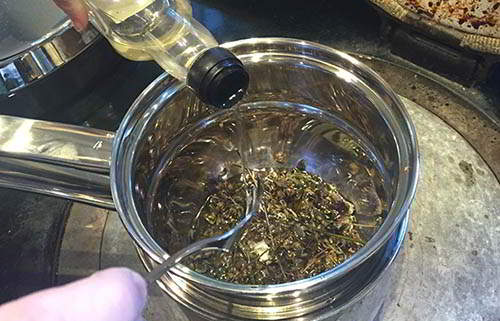
Making the Infused Oil
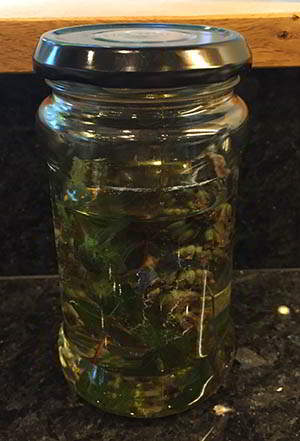 Place your mix of dried herbs into the double boiler (as shown above). Cover the herbs with oil so there is about 1 inch of oil covering the top of the herbs. If you shred or grind the herbs up, you’ll increase the surface area and so improve extraction of the active ingredients.
Place your mix of dried herbs into the double boiler (as shown above). Cover the herbs with oil so there is about 1 inch of oil covering the top of the herbs. If you shred or grind the herbs up, you’ll increase the surface area and so improve extraction of the active ingredients.- Using a low heat, warm the oil and herbs for 1-5 hours, until the oil turns the color of the herbs. If you have a ‘warming oven’ (typically used in bread making) you can leave the mix of oil and herbs in a glass proof bowl in that oven for around 48 hours. This will also extract the active ingredients from the plants.
- Strain the oil to remove any plant debris. Be careful as the oil will be hot
- Keep the herb infused oil in a jar in a cool place ready for salve making
NOTE: If you don’t have a double boiler you can instead use a heat proof glass bowl on a pan of water – be careful not to overfill the pan as the water, when boiling makes the glass bowl ‘jump’.
Slow Method:
Collected herbs in jar – using in-direct sunlight to extract the active ingredient into oil
Ingredients:
- Dried Thyme
- Dried Lavender
- Dried Comfrey (use the leaves and flowers from the plants)
- Olive oil or nut oil
- Jar with tight lid
- Something to strain the oil (cheesecloth or similar)
- Some sunshine
Making the Infused Oil
- Place the dried herbs, either chopped or loosely shredded into the jar
- Pour the oil over the herbs covering them
- Leave in in-direct sunlight for around 3-4 weeks
- Every day give the jar a shake or two
- Once the oil starts to take on the color of the herbs and smells of lavender and thyme, it is time to strain
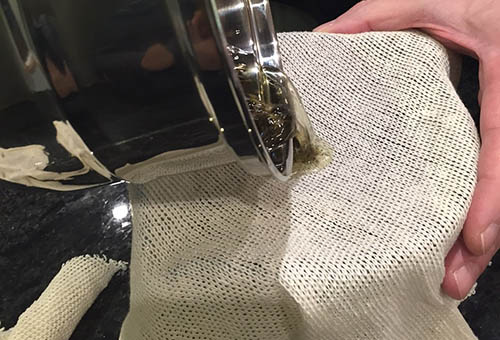
Strain the oil through cloth to remove the plant debris and leave clear oil - Using the cloth, strain the oil until the plant debris is removed
How to Make a Salve Base
The salve base is the medium that holds the active ingredients. This is also the method used to distribute and absorb those active ingredients onto, and to an extent, through, your skin. The salve is based on beeswax but you can also use other safe waxes such as Carnauba wax (palm wax).
Ingredients
- 4 oz of a herbal infused oil such as that described in the section “Preparing the Plants for Salve Use”
- 1/2 – 1 oz beeswax pellets (amount depends on how thick you want the salve to be)
- 10-20 drops of essential oils such as Tea Tree or lavender (optional)
- Double boiler (you can use a commercial one, or a make-shift one as I have done below)
- Some tins or small glass jars to hold the salve
Making the Salve Base Using the Infused Herbal Oil
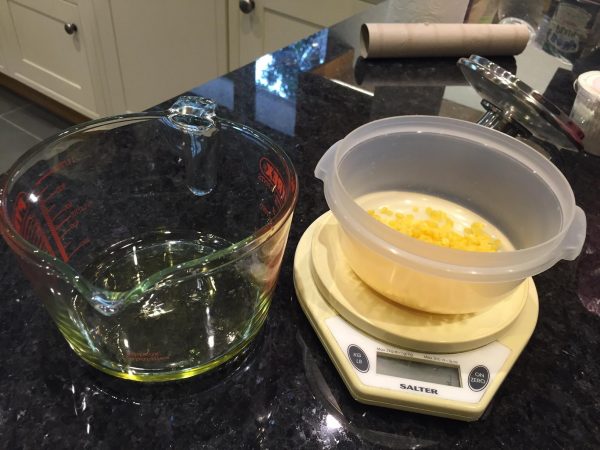
- Place the beeswax pellets into the double boiler. Alternatively, use a heat proof glass bowl over a pan which contains water, in the same method you would use to melt chocolate. Be careful not to overfill with water as it will make the glass bowl ‘jump’.
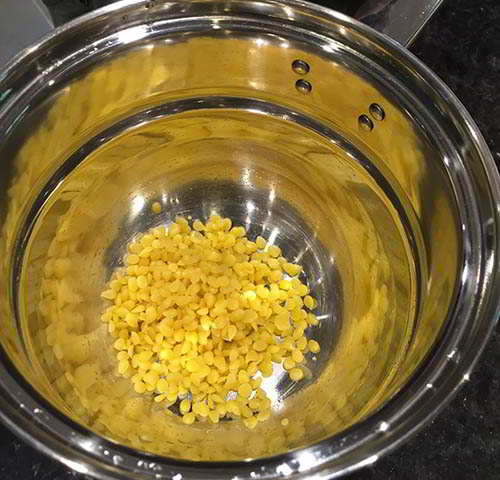
- Add the infused herbal oil to the softened beeswax and slowly heat and mix. You might find the wax starts to thicken when you add the cold oil, let it heat up and mix in the warmed oil/wax. Mix the melting beeswax using the handle of a wooden spoon or similar. Once the beeswax is completely melted, slowly add the infused oil to the melted wax in the double boiler. Mix as you pour. You’ll notice the wax starting to solidify as the colder oil hits it. Continue to heat and stir until the wax re-melts. Stir the two until completely mixed.
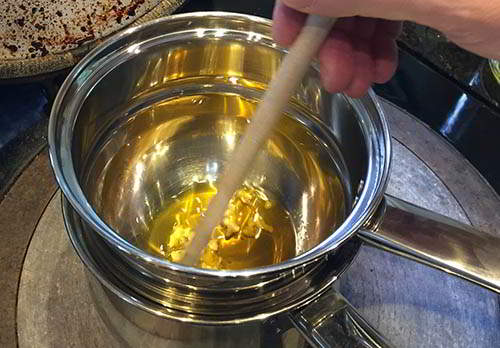
- Once thoroughly mixed, remove from the heat
- Allow to cool and then add in the essential oils (if using) and mix. I used a few drops of lavender oil in my mix at this stage
- Pour the cooled, but still soft, salve into your containers. Use a clean tin or glass jar.
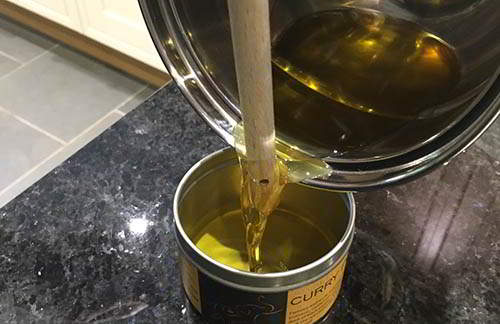
- Leave for about 15 minutes in a fridge or very cold place to harden the wax
- Use you salve on the clean cut or wound or to add to bandages
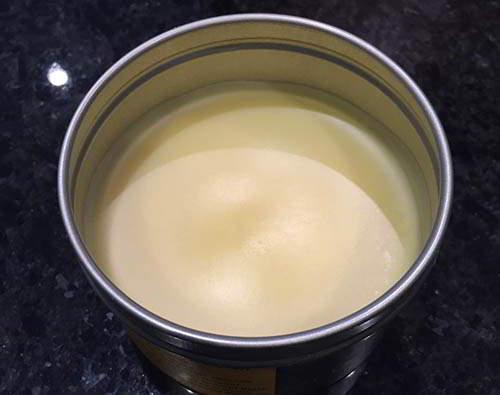
Other herbal / plant mixtures that can be used in salves:
- Menthol and peppermint: This combo is perfect for rubbing onto chests at night before sleep to help ease the symptoms of a cold or chest infection.
- Elderflower, Aloe, Lavender: Used in a salve for soothing sunburn.
- Clendula infused in coconut oil: Perfect for relieving eczema.
- Honey (preferably Manuka) used with coconut oil in the salve: For soothing burns.
You may also like:
How I Make My Own Cough Mixture
An Insanely Effective Way to Build a 5-year Food Stockpile (Video)
How to Get Your Wife and Kids Involved in Prepping
79 Edible Flowers in North America (with Pictures)
6 Powerful Natural Anti-Inflammatory and Pain Relief Agents for When SHTF

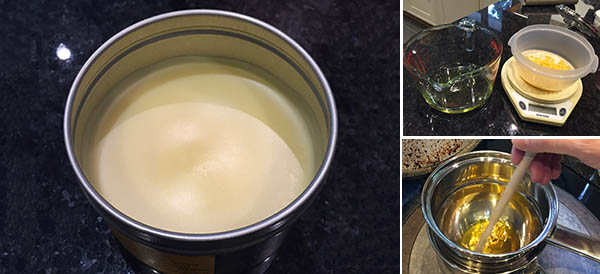













what are the quantities of herbs to be used /
I used literally a handful of thyme and about 8 sprigs of lavender (also included 4 drops of lavender oil) which were ground up as finely as possible (doesn’t have to be ground to a powder, it’s just to increase the surface area for extraction)
But to be honest, as long as it’s enough to be just covered by the oil for infusion that’s enough.
Lavender/oi on humans is desinfection And Woundhealing. if its all about woundhealing use more lavenderoil, it heals up burnwounds quicker too. (supertip: frozen along with aloeveragel and some cbdoil, ultimate firstaid, not open wounds though, then only soft cooling with cool water for 10 minutes at a time and maybe some aloe). experience talking here. on rashes and scrapes use first wash thoroughly with roomtemp camomilletea(everyday at least 2 times refresh), then some honey and then take 1 or more sageleafs softside towards the scrape or cut or pussing/necrotisizing wound, if you have a cavity or an abces also with animals, take 1(or more) sageleafs and cut most of the leaf of and put the stalk of the leaf(s) into the cavity, it looks then like a whale’s tail out of the wound, easy to take out to refresh1 a day and it keeps the abces open so it can keep draining out. Heals like a miracle. Sage is a miracle. In abcesses the sage produces some kind of tea which speeds up the cleaning enormously. refresh only once a day so the tea can form in the abces. be sure to have sage around in the garden its instant woundcare and does not stick!! to any wound. And it absorbs the moisture of wet wounds and cleans them, therefore superficial wound should be refreshed with a new leaf(s) twice a day. morning and evening. Again: softside towards wound.
with love from MJ (also for diabetic wounds)
Being told that Comfrey was a pain killer for muscle and bone pain, I have tried making it by several different recipes including this one. Unfortunately, it did not work as a pain killer.for me or my husband suffering from shoulder and neck pain. Of course having to guess at the amounts to use in this recipe may be taken into account.
Great article! When we lived in Germany in the late 1970s I developed pneumonia. I was shocked when the M.D. prescribed an antibiotic salve to rub on my chest several times a day. I kept thinking, “Where’s the shot? Or the oral antibiotics?”
I got better just the same. They told me that, because the skin is the largest organ, many substances would be absorbed into the body in a disseminated way, and with fewer side effects, like an upset stomach. They were right!
Now I wonder, why don’t we use more salves here in the US?
Thanks for telling us how to make them!
Because we can choose to use the knowledge that our four mothers gave us … Doctors only know meds now now how to support a healthy body & mind..
I would tend to avoid both nut and seed oils as they rapidly go rancid, especially with heat. I prefer olive oil, coconut oil, jojoba oil (a liquid wax), or animal fat from pastured animals. And I often leave them as oils as they penetrate better than salves.
How long is the shelve life on these? Can they be kept for years, months, days?
FYI: Comfrey should NOT be used on deep wounds. It can make the wound heal too fast from the outside in. It’s fine on shallow cuts and wounds, though.
I watched a video of a genteman that removed the stem completely from the Comfrey leaves. He proposed the stems are too hard to dry. I feel that doing so would take away from the benefitual properties of the plant. Any suggestions?
My grandmother used goose grease to make salves as she thought it absorbed better. It worked, but ugh! what a smell!! I prefer to use coconut oil or olive oil. The coconut oil stays medium hard at room temp. in my house, the olive oil I add about one tablespoon of carnauba wax so it isn’t too hard.